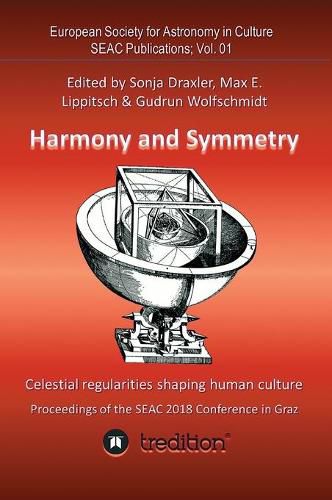Readings Newsletter
Become a Readings Member to make your shopping experience even easier.
Sign in or sign up for free!
You’re not far away from qualifying for FREE standard shipping within Australia
You’ve qualified for FREE standard shipping within Australia
The cart is loading…






For the SEAC conference in Graz (2018) and for the Proceedings the motto Harmony and symmetry - celestial regularities shaping human culture was chosen. There were at least two strong reasons for this motto: First, the connection between astronomy and human culture has an extremely long tradition, and one of its absolute high points is the astronomer Johannes Kepler, who spent his entire life searching for the relationship between the movement of heavenly lights and ideas about harmonious structures and regular bodies. Kepler started his scientific career and authored his first book, the Mysterium cosmographicum, in Graz. Kepler argued in his first publication for the twelve-fold partition of the zodiac with arguments derived from the monochord, anticipating the procedure he developed in his Harmonices mundi. Five contributions deal with Kepler, including the harmony in musical theory. The second reason was the Eggenberg Castle. This palace, built for the nobleman Hans Ulrich von Eggenberg (1568-1634), is a remarkable piece of symmetry and harmony and an outstanding example of a strong connection between astronomy and culture. Seven contributions have the topic astronomy, astrology and architecture with the emphasis on astronomical orientation, symmetry and harmony in the Middle Ages and Renaissance. The Proceedings with ten chapters and 44 contributions range besides the mentioned Middle Ages and beyond and Johannes Kepler from Prehistoric Times, Bronze and Iron Age, Mythology and Ethnoastronomy, Babylonian Astronomy, Greek and Roman Astronomy, Meso- and South America, Middle East and Eastern Asia and Computational Astronomy. The celestial sphere, regarded as the sky of astronomy, as well as the heaven of divine numina, from Antiquity to Copernicus and Kepler was equated with symmetry, harmony, and beauty. Until today, this has been reflected in the structure of cultural creations, from architectural objects to musical forms.
$9.00 standard shipping within Australia
FREE standard shipping within Australia for orders over $100.00
Express & International shipping calculated at checkout
Stock availability can be subject to change without notice. We recommend calling the shop or contacting our online team to check availability of low stock items. Please see our Shopping Online page for more details.
For the SEAC conference in Graz (2018) and for the Proceedings the motto Harmony and symmetry - celestial regularities shaping human culture was chosen. There were at least two strong reasons for this motto: First, the connection between astronomy and human culture has an extremely long tradition, and one of its absolute high points is the astronomer Johannes Kepler, who spent his entire life searching for the relationship between the movement of heavenly lights and ideas about harmonious structures and regular bodies. Kepler started his scientific career and authored his first book, the Mysterium cosmographicum, in Graz. Kepler argued in his first publication for the twelve-fold partition of the zodiac with arguments derived from the monochord, anticipating the procedure he developed in his Harmonices mundi. Five contributions deal with Kepler, including the harmony in musical theory. The second reason was the Eggenberg Castle. This palace, built for the nobleman Hans Ulrich von Eggenberg (1568-1634), is a remarkable piece of symmetry and harmony and an outstanding example of a strong connection between astronomy and culture. Seven contributions have the topic astronomy, astrology and architecture with the emphasis on astronomical orientation, symmetry and harmony in the Middle Ages and Renaissance. The Proceedings with ten chapters and 44 contributions range besides the mentioned Middle Ages and beyond and Johannes Kepler from Prehistoric Times, Bronze and Iron Age, Mythology and Ethnoastronomy, Babylonian Astronomy, Greek and Roman Astronomy, Meso- and South America, Middle East and Eastern Asia and Computational Astronomy. The celestial sphere, regarded as the sky of astronomy, as well as the heaven of divine numina, from Antiquity to Copernicus and Kepler was equated with symmetry, harmony, and beauty. Until today, this has been reflected in the structure of cultural creations, from architectural objects to musical forms.